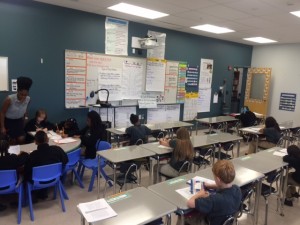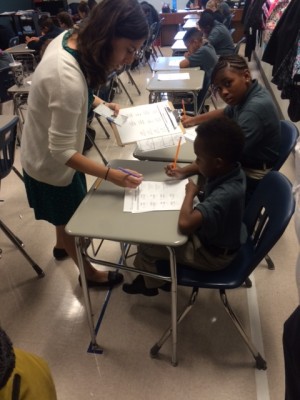08.26.16Postcard from Troy Prep: Observations on Double Planning, Nonverbal Interventions, Systems & Routines
I had the pleasure of visiting Troy Prep, yesterday, Uncommon’s school in the small upstate city of Troy that’s led by principals Lauren Catlett (Middle) and Sam DeLuke (Elementary). I had a series of realizations and inspirations and thought I’d share a few of them here.
- On Jamila’s Classroom
One of my first stops was Jamila Davis’ classroom.
Here’s a picture of it:

What I loved is the balance of expectations, warmth, productivity and autonomy. Jamila’s in the corner reading with 6 or 7 kids. Her co-teacher, Brittney Moore, is in the other corner with 6 or 7 more. And 8 or so students are out at their desks in the middle of the room, reading independently and writing, each one with incredible focus and industry. I mean total focus. Jamila achieves this by stressing and investing in systems and routines. She smiles warmly all the way, but she’s incredibly diligent about establishing habits for how to do things right: how to move from desk to table; how to get out your things and work on your own, etc. They practice these things for the first days and weeks so they can be productive and independent for the rest of the year.
When the 8 kids at their desks move to the side table to read with Jamila, and the kids at her table move to Brittney’s station, for example, Jamila merely says: “Transition” and that word cues them for what to do: off they go- everyone to their new place without reminders or distractions and all in about 15 seconds. When you have orderly systems for how to do the mundane tasks right you can actually give kids more autonomy in the classroom. After all, if it isn’t working perfectly, Jamila can reset expectations in about 2 seconds flat.
2. Jamila’s Comment About Her Nonverbals
My biggest epiphany of the day came when I was standing in the back of Jamila’s room talking to Katie Yezzi, the school’s founder and leader. If Jamila’s name is familiar to you it might be because our team recently blogged about a video we shot showing her masterful use of non-verbal interventions while she was teaching. If you haven’t, it’s really worth a watch, so here it is again:
The idea here is that Jamila manages to direct (or re-direct) her students with subtle nonverbal gestures while she’s still teaching and that means that the learning task never stops for her kids.
Anyway, I was standing in the back of Jamila’s classroom and asked Katie if Jamila had seen the video. She had. And what she had told Katie about it was truly fascinating. She said she had not even realized she was making the nonverbal corrections she was making. The staff at Troy Prep had trained on using nonverbals quite some time ago but the footage I had used was shot much later. Jamila was working on her guided reading ideas and was totally focused on refining her own questioning and ability to assess students reading midstream. In other words, her mind was on something else. And really this is exactly how it should be. She was thinking about her content and the story and her questions. But because she had practiced her nonverbals, they came out anyway. And this is important because our active processing capacity is limited. As teachers trying to do complex work in complex environments, we are constantly bumping up against the limits of the number of things we can concentrate on or even think about at any one time… so Jamila’s comment shows the power of practice. If you can make your skills–your questions, your nonverbals, what have you–automatic through practice, you can clear more space to think actively either about the content or about some new and arguably more nuanced skill you want to master.
3. A Great Example of Double Planning
I also had a moment to observe Gina Grasso’s 5th grade math class. She sent kids off to do a set of problems on their own for 3 or 4 minutes. Kids raced to it with vigor and spirit (especially the two scholars in the photo below…. man, were they killing it!). But in those few minutes, I observed Jenna get around to almost every kid in the room to check their work, gather data, and give feedback. She was able to make note of common mistakes on her clipboard, so afterwards she could take a moment to re-teach a key idea or two. She was able to praise industrious scholars. She was able to make sure of where everyone was–and that everyone did every problem.
A big reason she was able to do this was the design of her lesson materials. As I describe in the section on Double Planning in TLaC 2.0, her materials are packet based: Problem sets, demonstrations, space to explain answers all in one handy and consistent packet. Gina had a key on her clipboard and could check answers efficiently but she could also find those answers quickly on everyone’s desk because it was in the same place every time. And this meant speed. It meant Gina could get to everyone in 3 or 4 minutes.
You can see her doing that here. (It was all stars for these two. 🙂 ).

One other thing I noticed about the math materials at Troy Prep: They were exemplars of Double Planning. Not only was everything in one place, which aided with pacing and Checking for Understanding but there was something that I call (on page 151 of the 2.0 version) “Embedded Adaptability.” The idea is that a lesson plan should be “a living breathing document.” It should react to kids and their needs in real time, which is different for every class in unpredictable ways. The lesson Gina was teaching had more problems in the packet than kids would actually get to in the lesson. Gina could pick and choose depending on how things went–not only for the whole class but for individual kids. In fact, the problems were labeled Mild, Medium or Spicy. Everyone in class needs to master the mediums. But for a kid who’s crushing it, Jenna could say, “Great go ahead and try a few spicy ones on your own.” Or she could say to the whole class, “Wow, we’re really getting it. Let’s try some spicy ones!” Or she could say to the class: “Hmmm. Seems like we’re struggling with a key concept here. Let’s flip back to our mild problems and just make sure we’ve got the fundamentals.” etc. In other words, the three catch-ily named categories allow her to adapt the lesson as she goes according to what her students need.

Can we see more videos of Jamila Davis? She is amazing.